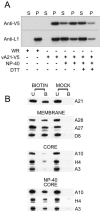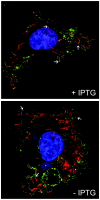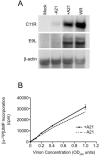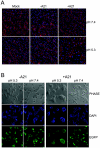Vaccinia virus A21 virion membrane protein is required for cell entry and fusion
- PMID: 16014909
- PMCID: PMC1181583
- DOI: 10.1128/JVI.79.15.9458-9469.2005
Vaccinia virus A21 virion membrane protein is required for cell entry and fusion
Abstract
We provide the initial characterization of the product of the vaccinia virus A21L (VACWR140) gene and demonstrate that it is required for cell entry and low pH-triggered membrane fusion. The A21L open reading frame, which is conserved in all sequenced members of the poxvirus family, encodes a protein of 117 amino acids with an N-terminal hydrophobic domain and four invariant cysteines. Expression of the A21 protein occurred at late times of infection and was dependent on viral DNA replication. The A21 protein contained two intramolecular disulfide bonds, the formation of which required the vaccinia virus-encoded cytoplasmic redox pathway, and was localized on the surface of the lipoprotein membrane of intracellular mature virions. A conditional lethal mutant, in which A21L gene expression was regulated by isopropyl-beta-d-thiogalactopyranoside, was constructed. In the absence of inducer, cell-to-cell spread of virus did not occur, despite the formation of morphologically normal intracellular virions and extracellular virions with actin tails. Purified virions lacking A21 were able to bind to cells, but cores did not penetrate into the cytoplasm and synthesize viral RNA. In addition, virions lacking A21 were unable to mediate low pH-triggered cell-cell fusion. The A21 protein, like the A28 and H2 proteins, is an essential component of the poxvirus entry/fusion apparatus for both intracellular and extracellular virus particles.
Figures









Similar articles
-
The product of the vaccinia virus L5R gene is a fourth membrane protein encoded by all poxviruses that is required for cell entry and cell-cell fusion.J Virol. 2005 Sep;79(17):10988-98. doi: 10.1128/JVI.79.17.10988-10998.2005. J Virol. 2005. PMID: 16103150 Free PMC article.
-
Entry of vaccinia virus and cell-cell fusion require a highly conserved cysteine-rich membrane protein encoded by the A16L gene.J Virol. 2006 Jan;80(1):51-61. doi: 10.1128/JVI.80.1.51-61.2006. J Virol. 2006. PMID: 16352530 Free PMC article.
-
Vaccinia virus H2 protein is an essential component of a complex involved in virus entry and cell-cell fusion.J Virol. 2005 Apr;79(8):4744-54. doi: 10.1128/JVI.79.8.4744-4754.2005. J Virol. 2005. PMID: 15795260 Free PMC article.
-
Viral glycoprotein-mediated cell fusion assays using vaccinia virus vectors.Methods Mol Biol. 2004;269:309-32. doi: 10.1385/1-59259-789-0:309. Methods Mol Biol. 2004. PMID: 15114023 Review.
-
The exit of vaccinia virus from infected cells.Virus Res. 2004 Dec;106(2):189-97. doi: 10.1016/j.virusres.2004.08.015. Virus Res. 2004. PMID: 15567497 Review.
Cited by
-
The myristate moiety and amino terminus of vaccinia virus l1 constitute a bipartite functional region needed for entry.J Virol. 2012 May;86(10):5437-51. doi: 10.1128/JVI.06703-11. Epub 2012 Mar 7. J Virol. 2012. PMID: 22398293 Free PMC article.
-
The Ectodomain of the Vaccinia Virus Glycoprotein A34 Is Required for Cell Binding by Extracellular Virions and Contains a Large Region Capable of Interaction with Glycoprotein B5.J Virol. 2019 Feb 5;93(4):e01343-18. doi: 10.1128/JVI.01343-18. Print 2019 Feb 15. J Virol. 2019. PMID: 30463966 Free PMC article.
-
Poxvirus cell entry: how many proteins does it take?Viruses. 2012 May;4(5):688-707. doi: 10.3390/v4050688. Epub 2012 Apr 27. Viruses. 2012. PMID: 22754644 Free PMC article. Review.
-
Vaccinia virus G9 protein is an essential component of the poxvirus entry-fusion complex.J Virol. 2006 Oct;80(19):9822-30. doi: 10.1128/JVI.00987-06. J Virol. 2006. PMID: 16973586 Free PMC article.
-
Lipid membranes in poxvirus replication.Viruses. 2010 Apr;2(4):972-986. doi: 10.3390/v2040972. Epub 2010 Apr 6. Viruses. 2010. PMID: 21994664 Free PMC article.
References
-
- Ahn, B.-Y., P. D. Gershon, and B. Moss. 1994. RNA-polymerase associated protein RAP94 confers promoter specificity for initiating transcription of vaccinia virus early stage genes. J. Biol. Chem. 269:7552-7557. - PubMed
-
- Antoine, G., F. Scheiflinger, F. Dorner, and F. G. Falkner. 1998. The complete genomic sequence of the modified vaccinia Ankara strain: comparison with other orthopoxviruses. Virology 244:365-396. - PubMed
-
- Bablanian, R., B. Baxt, J. A. Sonnabend, and M. Esteban. 1978. Studies on the mechanisms of vaccinia virus cytopathic effects. II. Early cell rounding is associated with virus polypeptide synthesis. J. Gen. Virol. 39:403-413. - PubMed
Publication types
MeSH terms
Substances
Associated data
- Actions
LinkOut - more resources
Full Text Sources
Other Literature Sources

